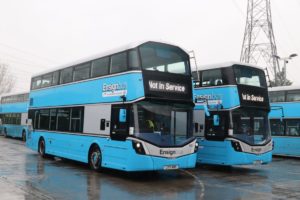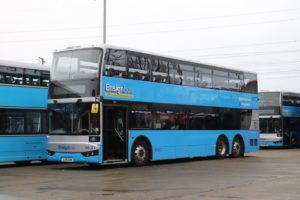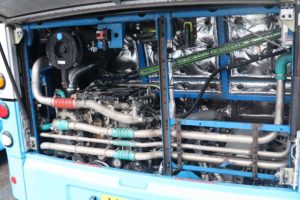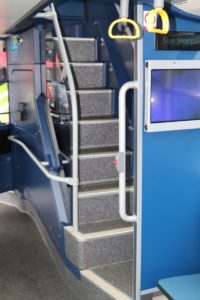EnsignBus maintains double-deck investment
Staurt Jones takes a look at the Purfleet operation’s latest double-deck investments, Wrightbus Streetdeck Ultroliner Mild Hybrids
Over the past 40 years I doubt whether any company has bought and sold more used double-deck buses than EnsignBus, the Purfleet based dealer and operator run by the Newman family. It has also bought batches of new buses for its local bus, rail replacement and contract operations. The operating side has a network of commercial services centred on the Lakeside shopping centre’s bus station. The last 12 months have seen very considerable investment in the fleet which now stands at 69 buses, without including around 50 active heritage buses and a further eight that have still to be restored. Currently operational are 13 Volvo B9TLs, six Volvo B5LHs, three Volvo B7L Ayats Bravos, an ADL Enviro 400, an ADL Enviro500, 11 BCI Excellence two-axle, six BCI Enterprise three-axle, seven ADL Enviro200 single-deckers and the newest purchases, 21 Wrightbus Streetdeck Ultroliner Mild Hybrids.
StreetDeck
Introduced in 2014 when it heralded the so called ‘stealth’ streamlined frontal styling, the StreetDeck is an integral double-deck bus offered by Wrightbus under its own brand. It has the same axle modules as the New Bus for London, and together with that model, the StreetDeck stepped up efforts to broaden Wrights’ product portfolio beyond offering aluminium bodies on other manufacturer’s chassis.
Wrightbus continued to build on other chassis, especially Volvo’s B5TL and B5LH, offering the latest version of the Gemini III range which was outwardly similar to the StreetDeck. The new StreetDeck followed the trend of installing smaller capacity engines running at higher speeds and saw a switch from Cummins to Mercedes-Benz engines. These four cylinder units offer similar or greater torque levels to bigger engines while providing improved fuel economy. At the time it was unusual for a UK double-decker to use a Mercedes-Benz engine, although Optare also did so, in the shape of the four-cylinder OM934 5.1-litre mounted longitudinally at the rear. The transmission options were the Voith D854.6 four-speed automatic, Daimler G90AMT six-speed automatic and the ZF EcoLife six-speed automatic.
From the outset, it was intended that the StreetDeck range would grow. It would not only be a diesel but also, in line with Sir William Wright’s pioneering ecological credentials, be offered progressively in variants that offered reduced or zero-emissions. As well as the diesel powered StreetDeck Ultroliner as it is now known, with either four or later six-cylinder engines, the current range includes the full hybrid Ultroliner HEV, the hydrogen fuel-cell electric Hydroliner FCEV and the battery electric Electroliner BEV.

The purchase of 21 new StreetDeck Ultroliners in one year represents a significant investment and continues a long association with the Ballymena manufacturer
Prior to the collapse of the original Ballymena-based Wrightbus company in September 2019 the manufacturer was in the process of fulfilling an order for low-height single-door StreetDeck double deckers for Arriva, who had originally taken the first StreetDeck prototype in 2014 before full production began the following year. The first part of the order had been supplied and entered service before the collapse but the final seven buses were not taken and more than a year later were offered to EnsignBus by the new owners. At the time the Mayor of London was extending the LEZ to Rainham and Ensignbus was running a lot of contracts for both Amazon and TfL that necessitated entering the zone. Faced with this need for Euro VI buses that was stretching resources, Peter bought all seven, taking them as built to the Arriva Sapphire specification. Delivered in the January, they were repainted at Marden Commercials and entered service with 21-plates in March 2021.
Ensign’s commercial network is close to London but not within it so there was no need to have TfL’s requirements with all the extra cost and complexity (and weight) that involves. Accordingly, the chosen specification is for single- rather than dual-doorway buses. A manual ramp is fitted. The next-stop announcement system was already installed but CCTV had to be added. It is not the i-Bus system used in London and local arrangements were made for a lady to record the necessary information. The buses not being contracted to TfL also means that Ensign’s attractive silver and blue livery can be applied rather than drab all-over red. Judge for yourself which looks most attractive to passengers next time you are in Lakeside Bus Station.
The initial buses proved fuel-efficient and later in 2021 EnsignBus took delivery of a further 14 StreetDeck Micro Hybrids. The second batch, numbering 14 buses, differ from the first seven in a number of ways. Firstly they are higher, with an overall height of 14’3” rather than 13’10”, which makes a considerable difference to the upper-deck headroom. They also have glazed top-deck front corner panels rather than solid ones, which is a big improvement for passengers in the front seats. Having kept the interiors specified for its Arriva’s Sapphire services with plain blue e-Leather seats on the low height examples,
Ensign specified its standard blue patterned moquette featuring coloured pictures of buses and the company logos, and they look much more cheerful and welcoming for it. Peter Newman commented: “We purposely didn’t change the specification too much because the more standardization you have the better.” He also revealed that he had done a five-year deal with Wrightbus to provide a five-year warranty on major units.
The purchase continues a good relationship with Wrightbus. Some 39 of the 69 frontline buses were built in Ballymena. “My personal bus is one of the 15-plate B9TL Wright Eclipse Gemini 2s and it is reliable and doesn’t rattle,” said Ross Newman, Operations Director. “We’ve always liked the Wrightbus product.” He thinks the 15-plate B9TL Gemini 2s are “the most reliable buses we’ve ever operated.”
Economy
Much was made at the time of its launch about the economy the StreetDeck offered. Switching to a cassette-mounted longitudinal driveline, without the angle drive previously required, was said to reduce fuel used by between 2% and 4%.
All of the EnsignBus StreetDecks have the four-cylinder EuroVI Mercedes-Benz OM934 engine rated at 170kW (228hp). They referred to independent tests at Millbrook in which a StreetDeck with MicroHybrid system returned 9.05mpg. This does seem to have been borne out in operation because Peter Newman told me that the buses were returning 8.3mpg, while Ross said that, when used on the X80 service they could exceed 10mpg. The B9TLs are returning around 6 mpg and the Cummins engine BCI deckers around 7 mpg.
Also significant is the mild hybridisation package, now in its third generation, which charges batteries using energy recaptured during braking and uses it to power the ancillary systems, thereby reducing the overall power requirement.
The other factor is weight, although the smaller engine is responsible for part of this reduction. It was around a tonne lighter than its predecessor with savings throughout. Comparing unladen weights in Ensign’s yard, the lowbridge StreetDecks come in at 10,717kg and the standard height version still under 11-tonnes at 10,967kg. In comparison, two B9TL Wrightbus Geminis I looked at were 11,525kg and 12,400kg, though the latter did have bonded glazing and an electric rather than manual ramp. The BCI deckers showed 12,460kg for the two-axle model and 15,500kg for the tri-axle seat-belted ones.
Asked whether they had been tempted to look at options other than diesel propulsion, Ross Newman said that problems with electric were space, cost and the electrical supply to the estate. He notes that with electrics, the last bus in has to be the last bus out which needs a complete change to the traditional last bus in, first bus out approach. “We would need so much extra room that we just haven’t got the space on site. There is also the fact that the industrial estate hasn’t got the necessary power, so it’s a non-starter.” He believes hydrogen is the best long term solution if the technology can be perfected, “because the existing infrastructure can stay the same.”
The buses are used across the bus network with the exception of the 99, which is the preserve of single-deck 200MMCs, and can be seen on the 22, 33, 44, 66, 73, 73A, 77, 77A, 83, 88, and X80 as well as Z1, Z2 and Z4 Amazon contracts. Ross said: “The StreetDecks do the shorter runs. We tend to use the Volvos on longer distance rail replacement because they have bigger engines and we feel they are better on motorways as they are working less hard.”
They have a capacity of 100 passengers. The permutations are: 74 seated + 26 standees + 0 wheelchair, 68 seated + 32 standees + 0 wheelchair or 68 seated, 31 standees and 1 wheelchair. The wheelchair site is on the nearside with three tip-ups and an ironing board restraint with the buggy bay and three more tip-ups on the offside beyond the staircase.
Peter pointed to one problem with the small engine StreetDecks, they are limited to 50mph. With this in mind they are only used locally.
Asked about their performance when climbing, he said: ‘We only have one hill at Chadwell St Mary and they manage it all right.”
More power
The Go-Ahead Group has been among the most enthusiastic purchasers of the StreetDeck and in 2020 the Go North East business, which had taken its first StreetDecks at the beginning of 2015, took delivery of one with the larger 7.7-litre, six-cylinder OM936 engine for use on its X-Lines express routes. It was reported to have an up-rated rear axle and a top speed of 62mph. Ross said: “I have heard very good reports about how smooth and comfortable the GNE one is, but I haven’t had chance to go on it yet, so I’m looking forward to that.”
Another similarly engined dual-door StreetDeck with air-conditioning had been supplied to the major Hong Kong operator, KMB, in February 2018 as a demonstration vehicle. Though it subsequently ordered a large batch of StreetDecks, KMB did not keep this bus and it returned to England where Ensign purchased it. Currently undergoing conversion in the workshops, the former demonstrator has had the centre door removed, requiring the installation of an emergency door at the offside rear. A manual ramp is in the process of being installed at the front door. Inside, the original seats were too wide to satisfy UK requirements and are being replaced with new ones as well as being altered to meet UK operating needs. Ross expects it to be on the road in March.
Buying the StreetDecks does not mean that Ensign will never buy Volvo again. Ross said: “If we could still buy B9TLs we would, come to that Metrobuses. What I really want Volvo to build is a two-axle B8L, but they won’t. We would buy more StreetDecks but we would want six-pot ones, which is why we are looking forward to having the Hong Kong demonstrator on the road.”
Last word
Overall, the company has been pleased with the purchases. Ross describes them as “better than I expected,” adding: “I have been impressed with the Wrightbus warranty support. They are pretty much always here next day.”
“We have had the first seven for a year now and there have been some niggling things but nothing major. They are doing the job,” said Peter Newman. “They are reliable, the ride is nice, and they don’t rattle and bang like some of the competition.
“Service is very good, I’m happy with the response if we need anything. We have been pleasantly surprised.”
The plan is that the StreetDecks will be kept for a full working life of 12 to 13 years as is normally the case in the fleet. Last year all but one of the 2008 batch of Optare Olympus-bodied Volvo B9TLs were sold, making way for the later StreetDecks. It is usually EnsignBus policy to retain one bus from each significant batch of vehicles owned for the heritage fleet, so it is quite likely that in the mid-2030s one of the StreetDeck Ultroliners will enjoy the same active retirement.
Buses from BCI
I couldn’t visit Purfleet without also having a brief look at the Chinese built BCI double-deckers that, uniquely in the UK, EnsignBus operates and was the UK dealership for.

This is one of two BCI Enterprise 2s that were originally ordered by Reading Buses with dual purpose seats. They accommodate 91 seated passengers whereas those ordered by EnsignBus can carry 98
The first of these were four 12.5m tri-axle Enterprises with dual-purpose seating and air conditioning that entered service in September 2016. On why he bought them, Peter said: “I couldn’t find anything else that fitted our requirements at the time. Volvo couldn’t do a longer B9TL, they could only do a long B5TL with an MCV body and MCV couldn’t do seatbelts.” He also disliked the staircase options offered. All were fitted with the Cummins ISL six-cylinder EuroVI engines and ZF automatic transmissions.
They were followed in June 2017 by 10.5m long two-axle Excellence deckers. “We were able to specify what we wanted,” said Peter, “such as old-fashioned heating so that they were always warm and nice.” These were ordered as 80-seaters but weight issues saw this reduced to 78-seats (51/27). The unladen weight of an Enterprise is 12,460kg. Most have bus seats but the final two are dual purpose with belts.
He admitted: “We had a few problems. Some components used were not as good as they could have been, but I think we have solved all of that now.”
There were originally 12 two-axle BCI Excellence deckers (including one demonstrator and one ordered by Aintree Coachline) and seven tri-axle BCI Enterprise or Enterprise 2 deckers although one of each has been lost since. The tri-axles include two Enterprise IIs ordered but not taken by Reading Buses which joined the fleet in June 2019 unlike the Ensign ordered buses, which seat 98 (61/37), these seat 91 (57/34). They have a ULW of 15,500kg and a maximum GVW of 24,000kg. A change made in the UK was the replacement of the original fixed windows with opening units. Ross credited the belted Enterprises with creating a new market for the company.
At the end of 2019, the company took delivery of their final BCI vehicle to date, an Enterprise 2. This, I believe uniquely in the UK, is equipped with a 380hp, 9.5-litre, engine from Weichai, one of the biggest engine manufacturers in China.
No more BCIs have been purchased for a number of reasons. Shipping costs have risen sharply and finding a boat is also a problem. Spare parts supply is getting more difficult with all manufacturers at the current time but it is exaggerated with the BCIs because of the distance involved. “Before the pandemic we weren’t waiting any longer for parts than with UK manufacturers,” said Ross who conceded that: “Communication with the company has become more difficult since the pandemic began.”
BCI Enterprise 2 Specification
|
Engine |
Mercedes-Benz OM934, 5.1-litre, four-cylinder, Euro VI |
|
Power |
170kW/228hp |
|
Transmission |
Voith D854.6 four speed automatic |
|
Rear axle |
ZF AV133 |
|
Front axle |
ZF RL82EC |
|
Tyres |
245/70Rx22.5 tubeless |
|
Dimensions & capacities |
Where two figures are shown, the first refers to the low height buses and the second to normal height batch |
|
Length |
10,567mm |
|
Width |
2,520mm |
|
Height |
4,220mm (13’10”)/4,395mm (14’3”) |
|
Wheelbase |
5,400mm |
|
Front overhang |
2,607mm |
|
Rear overhang |
2,560mm |
|
ULW |
10,717kg/10,967kg |
|
GVW |
18,468kg/18,600kg |
|
Fuel tank |
245-litres (190-litre option) |
|
AdBlue tank |
19-litres |
|
Passenger capacity |
74 seated + 26 standees + 0 wheelchair, 68 seated + 32 standees + 0 wheelchair or 68 seated, 31 standees and 1 wheelchair |

